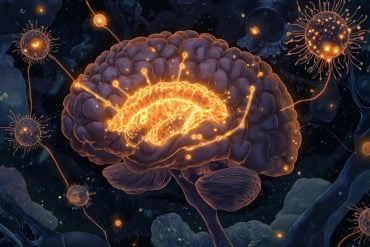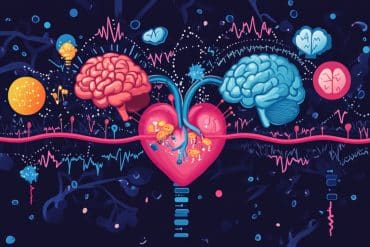Summary: A new study explores how brain networks differ between patients in early and chronic stages of psychosis, shedding light on symptom evolution. Researchers mapped connectivity patterns and found that disruptions in the frontoparietal network are key to both early and chronic psychosis symptoms.
Using machine learning on brain imaging data, the team could predict positive and negative symptoms with stronger predictions in chronic cases. These findings may help identify biomarkers for earlier interventions and improve treatment strategies before symptoms worsen.
Key Facts:
- Key Brain Network: Disruptions in the frontoparietal network are linked to psychosis symptoms across stages.
- Predictive Modeling: Machine learning models accurately predicted symptom severity using brain connectivity patterns.
- Treatment Implications: Early identification of brain network disruptions could guide more effective, targeted interventions.
Source: Yale
Patients in the early stages of psychosis respond to treatments differently than those who have developed a chronic version of the disorder.
Understanding the neurobiological changes from early to chronic stages is essential for developing targeted prevention and treatment strategies. But how symptoms change during this transition—and what role the brain plays—is unclear.

Researchers at Yale School of Medicine (YSM) have now examined patients with early and chronic forms of psychosis to map symptom evolution and identify relevant brain networks.
They published their findings in the journal Neuropsychopharmacology.
“We are interested in how psychosis and psychiatric disorders develop,” says Maya Foster, first author of the study and a PhD student in the lab of Dustin Scheinost, PhD, associate professor of radiology and biomedical imaging at YSM.
“With this study, we looked at the underlying brain networks—regions that are functionally connected and work in coordination—to link brain areas to symptoms in patients with either early or chronic psychosis, and we assessed the similarities and differences between these networks.”
Treating psychosis
The cause of psychosis symptoms are not well understood but are broadly believed to result from disrupted or altered brain activity.
What are known as “positive” symptoms of psychosis—in that they are added experiences healthy individuals don’t usually encounter—include hallucinations and delusions, while negative symptoms—or deficient versions of healthy experiences—include memory impairment, disorganized thinking, lack of motivation, and an inability to feel pleasure.
Patients with psychosis often experience negative symptoms first. As their psychosis worsens, positive symptoms emerge.
Despite their shared symptom experiences, early and chronic cases respond to treatment differently.
“Studies show that patients have better prognoses if they get treatment early,” says Foster. “Chronic psychosis has higher incidences of relapse, and available treatments do not work as well.”
Previous studies suggest that early interventions reduce psychosis symptoms, but longitudinal studies that follow patients through the transition from early to chronic condition have not yet been done. Filling in this information gap could help clinicians more effectively treat patients.
To begin to address this gap, Foster and Scheinost examined two large-scale open source datasets to identify how symptoms evolve in patients with early or chronic psychosis.
The Human Connectome Project Early Psychosis (HCP-EP) dataset contains information for early psychosis patients who present with symptoms within five years of data collection. The Strategic Research Program for Brain Sciences (SRPBS) Multi-disorder Connectivity dataset consists of patients with varying levels of symptom severity.
The HCP-EP dataset contained information for 107 participants, which was compared with data from 57 healthy participants. The SRPBS dataset contained information for 123 participants, which was compared with that of 99 healthy participants.
Mapping brain networks to psychosis symptoms
To identify connectivity patterns in the brain that underpin psychosis symptoms, the team trained a machine learning model on functional magnetic resonance imaging data and symptom information collected from individuals with early or chronic psychosis.
The researchers found the model was able to predict positive and negative symptoms in both groups. The predictions for the chronic psychosis population were stronger, likely because of greater symptom burden.
While psychosis arises from a disruption across the whole brain, the team found the frontoparietal network played a critical role in both early and chronic psychosis. This region of the brain is involved in cognitive flexibility, cognitive control, and coordinating behaviors.
According to Foster, negative symptoms may be linked to disruptions in the frontoparietal network.
These findings provide a neurobiological reference point that could allow clinicians to track symptom-based brain networks as patients transition from early to chronic psychosis, say the researchers.
“If we can characterize brain differences to better understand symptoms, then we could potentially identify targets or biomarkers,” says Scheinost.
“With more work, we might be able to predict transition points to monitor as you go along in treatment.”
Future research could track patients over time to uncover how the identified brain networks change throughout the lifespan of psychosis. This approach could inform treatment options to improve care and prevent worsening of symptoms.
Foster and Scheinost collaborated with psychiatrist Albert Powers, PhD, associate professor of psychiatry at YSM and co-author of the study, to contextualize their findings. Other Yale authors include Jean Ye and Nicha Dvornek, PhD.
Funding: The research reported in this news article was used data from the Human Connectome Project for Early Psychosis, sponsored by National Institutes of Health as part of human connectome initiative. The content is solely the responsibility of the authors and does not necessarily represent the official views of the National Institutes of Health.
About this psychosis and neuroscience research news
Author: Stacy Kish
Source: Yale
Contact: Stacy Kish – Yale
Image: The image is credited to Neuroscience News
Original Research: Closed access.
“Connectome-based predictive modeling of early and chronic psychosis symptoms” by Maya Foster et al. Neuropsychopharmacology
Abstract
Connectome-based predictive modeling of early and chronic psychosis symptoms
Previous research indicates that early (EP) and chronic (CP) psychosis share brain correlates and symptoms.
However, notable clinical differences, such as treatment responses and symptom severity, exist, suggesting the need for further investigation.
For example, the brain networks underlying EP and CP symptoms may be distinct, driven by factors like symptom severity and disease-related burden.
Differences, if any, in these brain networks are largely unknown because EP and CP have predominantly been studied, characterized, and compared to control populations independently.
This study’s objective was to directly compare the neural correlates of CP (n = 123) and EP (n = 107) symptoms using connectome-based predictive modeling (CPM) and resting-state functional magnetic resonance imaging.
We predicted both samples’ positive and negative symptoms from the Positive and Negative Syndrome Scale (PANSS). P
rediction effect sizes were higher in CP, and prediction of general psychopathology and total symptoms was only possible in CP.
Virtual lesioning analyses revealed the frontoparietal network as a critical component of EP and CP symptom networks. Predictive models were broadly similar between EP and CP.
We also generalized the EP positive score model to CP positive symptoms and identified group differences between CP and matched HCs more robustly than EP. Overall, broadly similar networks were found in CP and EP, but larger effects were observed in CP.
Our findings provide a foundation for longitudinal studies to track connectivity changes in symptom networks throughout the psychosis lifespan.
Similar stage-comparative approaches can enhance understanding of the etiology of early and chronic psychosis symptoms for therapeutic applications.







